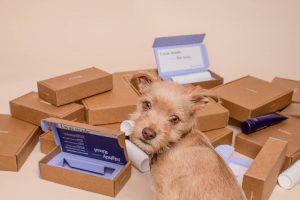A dog’s nasal bleeding is called epistaxis. Unlike men, this is rarely an episode without consequences. A nosebleed may be a sign of a more serious condition. What behaviour to adopt?
What are the possible causes of nasal bleeding in dogs?
In dogs, bleeding from the nose can be caused by a blow to the muzzle.
If your pet suffered trauma, the shock could have caused damage to the capillaries, which, when ruptured, cause nasal haemorrhage. The severity of the bleeding then depends on the severity of the trauma to the dog. If the shock was mild, the bleeding will be mild and will stop on its own. Although the impact was violent, it could have caused a fracture of the bones of the nose as well as an abundant haemorrhage which warrants an emergency consultation.
Bleeding can also be caused by a foreign object in your pet’s nose, such as spikelets.
But, in dogs, it is much more common for epistaxis to be the result of much more worrisome conditions such as:
primary coagulation disorders, secondary or not to intoxication by anticoagulant rat poison,
diseases of neoplastic origin (tumours),
chronic rhinitis,
an infectious disease caused by fungi (aspergillosis, for example), parasites (leishmaniasis, …), bacteria (ehrlichiosis, Bordetella, …) or viruses.
high blood pressure
hyperviscosity syndrome.
In all cases, you must obviously consult your veterinarian without delay.
How to help your companion?
While waiting for the visit to your veterinarian and in order to stop or slow the bleeding, you can:
compress your dog’s nose by exerting pressure towards the nasal septum as if you wanted to block his nose. Make sure your pet’s head is always tilted forward so that blood and clots that may form do not pass into the trachea and bronchi, which can lead to breathing difficulties. Maintain this compression for at least ten minutes. Avoid compressing the nose if there is severe trauma and a potential fracture, if your dog is showing signs of pain, or if he is not very cooperative.
Apply an ice pack to the top of your dog’s muzzle. The property of cold is to compress the blood vessels. To do this, place ice cubes in a bag (a freezer bag, for example) and then place this tied bag filled with ice cubes in another bag filled with cold water. Seal this bag tightly before applying it to the animal’s muzzle.
Take the time to calm your pet: the excitement increases the pressure and prevents the bleeding from subsiding.
Above all, never try to touch the inside of your dog’s nostrils or insert a compress inside, you may make the bleeding worse, and you may well get bitten! Leave it to your vet. He will then take over from you and decide on the care to be given to your animal, depending on the cause of his bleeding.





